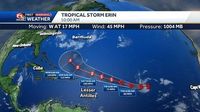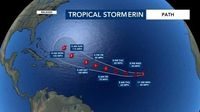Tropical Storm Erin, the fifth named system of the 2025 Atlantic hurricane season, is rapidly gaining attention from meteorologists, coastal residents, and travelers across the Atlantic basin. With August, September, and October historically marking the most active months of hurricane season, Erin’s projected strengthening into the first major hurricane of the year has prompted both caution and curiosity, particularly for those in Puerto Rico, Bermuda, and along the U.S. East Coast.
According to the National Hurricane Center (NHC), Erin is forecast to become a hurricane by Thursday, August 14, 2025, and is expected to intensify further into a strong Category 3 hurricane by the weekend of August 16-17. The storm’s current trajectory takes it north of Puerto Rico, with outer rain bands likely brushing the island over the weekend. While the direct impact on Puerto Rico is expected to be minimal, officials warn that rip currents will pose a significant risk for beachgoers not only in Puerto Rico but also in the Virgin Islands and the northern Leeward Islands. These hazardous surf and rip current conditions are forecast to persist into the following week.
Erin’s formation is notable for its timing. As reported by AccuWeather and cited by USA Today, Erin developed earlier than the historical average for the first hurricane, which typically forms around August 22. The first major hurricane of the season, defined as Category 3 or higher with sustained winds of at least 111 mph, usually does not appear until September 1. Erin’s rapid development and strengthening have, therefore, set the stage for a potentially active and unpredictable hurricane season, as predicted by the National Hurricane Center.
As of Wednesday, August 13, the storm was located approximately 1,305 miles east of the northern Leeward Islands, moving west at 17 to 20 mph, with maximum sustained winds near 45 mph and a central pressure of 1,004 mb. The NHC’s latest advisory indicates that Erin will begin to strengthen today, with forecasted wind speeds rising steadily: 50 mph within 12 hours, 60 mph in 24 hours, and reaching hurricane strength—75 mph—by Friday morning. By Sunday, August 17, Erin is expected to peak as a Category 3 hurricane with maximum sustained winds of 120 mph.
Despite the intensifying storm, the impact on Florida and the broader U.S. remains uncertain. No tropical storm or hurricane watches or warnings have been issued for Florida or the United States as of August 13. The NHC has emphasized that the forecast cone represents only the most likely path of the storm’s center and not the full breadth of potential impacts. With an average track forecast error of 150 to 215 miles at four to five days out, future adjustments remain possible. As the NHC noted, “There is even greater uncertainty in what impacts might occur in portions of the Greater Antilles, the Bahamas, the east coast of the United States, and Bermuda next week.”
Residents in Puerto Rico, the Virgin Islands, and the northern Leeward Islands are being urged to stay vigilant and monitor the storm’s progress. In a video update posted to social media, NHC warning coordination meteorologist Robbie Berg stated, “The track forecast has shifted a bit to the south. That does potentially increase the risks to the islands as we head into the weekend. We now have about a 25 to 30 percent chance of tropical storm-force winds on some of those islands. So now is the time to start thinking about getting some supplies ready just in case the storm is to move a little bit closer.”
AccuWeather lead hurricane expert Alex DaSilva told Newsweek, “AccuWeather still expects Erin to stay north of the Leeward Islands. While the core of the storm should stay to the north, there can be some wind and rain impacts in the islands. Very large waves and dangerous rip currents will be a big concern on the islands as well, especially the north facing beaches.”
For those watching from the U.S. East Coast, the main threat from Erin is forecast to be dangerous rip currents from about August 21 to August 27. Meteorologists warn that even though Erin is not expected to make landfall in the U.S., the storm’s influence will be felt along the coastlines, with rough surf and life-threatening conditions for swimmers and small craft. ABC7 New York meteorologist Brittany Bell echoed these concerns, stating, “Here’s the latest track for Tropical Storm Erin. The latest trends continue to show it curving north in the Atlantic, but it will bring rough surf and rip currents next week along our coastline.”
Forecast models, often referred to as “spaghetti models,” present a range of possible paths for Erin, highlighting the inherent uncertainty in hurricane forecasting. The NHC relies on the top-performing models to inform its official track, but notes that the center of the storm could travel outside the forecast cone up to 33% of the time. The storm’s future path will depend largely on the behavior of the Bermuda High—a massive area of high pressure over the central Atlantic—and the approach of a cool front and jet stream dip near the Atlantic Coast. As Alex DaSilva explained, “It is the shape of that oceanic high, as well as the approach of a cool front and dip in the jet stream near the Atlantic Coast, that will determine the exact track of the projected major hurricane as it approaches the Atlantic Coast of the United States next week.”
Several scenarios are still on the table. If the Bermuda High remains rounded or yields to the approaching cool front, Erin is likely to turn north before reaching the U.S. mainland. However, if the Bermuda High extends further west, it could block Erin’s northward path, resulting in a track closer to or even onshore in the U.S., particularly from the Carolinas northward. As of now, most models suggest Erin will curve out to sea, sparing the U.S. a direct hit but still delivering dangerous ocean conditions to the coast.
Erin’s development has not been without obstacles. Meteorologist Brooks Garner pointed out that Saharan Dust has slowed the storm’s intensification, delaying its transition to hurricane status by a day or two. Nevertheless, the consensus among meteorologists is that Erin will still achieve major hurricane strength, likely becoming the first Category 3 storm of the 2025 Atlantic season. This is significant, as none of the previous named storms—Andrea, Barry, Chantal, or Dexter—developed into hurricanes, though Chantal did bring heavy rain and flooding to North Carolina in early July.
As the Atlantic hurricane season runs through November 30, 2025, the coming weeks will be crucial for monitoring Erin’s progress and preparing for any potential impacts. Meteorologists and emergency officials continue to urge residents in vulnerable areas to stay informed, heed weather alerts, and have supplies ready in case the storm’s path shifts unexpectedly. With above-average water temperatures fueling Erin’s growth, and the busiest months of hurricane season still ahead, vigilance remains the watchword for communities across the Atlantic basin.
For now, all eyes remain on Tropical Storm Erin as it barrels westward, its future path and strength still uncertain. The coming days will reveal whether this early-season powerhouse will remain an offshore threat or become a more direct challenge for island and coastal communities.






